중요
번역은 여러분이 참여할 수 있는 커뮤니티 활동입니다. 이 페이지는 현재 20.17% 에서 번역되고 있습니다.
14.4. Lesson: Updating Forest Stands
Now that you have digitized the information from the old inventory maps and added the corresponding information to the forest stands, the next step is to create the inventory of the current state of the forest.
You will digitize new forest stands using an aerial photo. As with the previous lesson, you will use an aerial Color Infrared (CIR) photograph. This type of imagery, where the infrared light is recorded instead of the blue light, is widely used to study vegetated areas.
수종경계 디지타이즈 작업이 끝나면 삼림 보존 규제에 따른 새로운 제약 사항과 같은 정보를 추가할 것입니다.
The goal for this lesson: To digitize a new set of forest stands from CIR aerial photographs and add information from other datasets.
14.4.1. ★☆☆ Comparing the Old Forest Stands to Current Aerial Photographs
The National Land Survey of Finland has an open data policy that allows you downloading a variety of geographical data like aerial imagery, traditional topographic maps, DEM, LiDAR data, etc. The service can be accessed in English here. The aerial image used in this exercise has been created from two orthorectified CIR images downloaded from that service (M4134F_21062012 and M4143E_21062012).
Open QGIS and set the project’s CRS to ETRS89 / ETRS-TM35FIN in
Add the CIR image
rautjarvi_aerial.tifto the project:Go to the
exercise_data\forestry\folder using your file manager browserDrag and drop the file
rautjarvi_aerial.tifonto your project
Save the QGIS project as
digitizing_2012.qgs
이 CIR 이미지는 2012년도에 촬영된 것입니다. 1994년에 생성된 수종경계를 거의 20년 뒤의 상황과 비교해볼 수 있습니다.
Add the
forest_stands_1994.shplayer created in the previous lesson:Go to the
exercise_data\forestry\folder using your file manager browserDrag and drop the file
forest_stands_1994.shponto your project
Set the symbology for the layer so that you can see through your polygons:
사용자가 육안으로 동종 삼림으로 해석할 수 있는 지역과 옛날 수종경계가 얼마나 일치하는지 (또는 일치하지 않는지) 살펴보십시오.
해당 지역을 확대/축소 및 이동해보십시오. 옛날 수종경계 가운데 일부는 지금도 이미지와 일치할 수도 있지만, 일치하지 않는 수종경계도 있다는 것을 알 수 있을 것입니다.
This is a normal situation, as some 20 years have passed and different forest operations have been carried out (harvesting, thinning…). It is also possible that the forest stands looked homogeneous back in 1992 to the person who digitized them but as time has passed some forest has developed in different ways. It is also possible that that forest inventory priorities back then were different from those of today.
이제 옛날 수종경계 없이 이 이미지로부터 새로운 수종경계를 생성해보겠습니다. 나중에 두 수종경계의 차이를 비교해볼 수 있을 겁니다.
14.4.2. ★☆☆ Interpreting the CIR Image
도로와 호수 사이로 제한돼 있는 예전 목록 정보가 커버하는 지역을 디지타이즈해봅시다. 전체 지역을 디지타이즈할 필요는 없습니다. 이전 강의에서와 마찬가지로 대부분의 수종경계를 이미 담고 있는 벡터 파일을 사용할 수 있습니다.
Add the file
exercise_data\forestry\forest_stands_2012.shpto the projectSet the styling of this layer so that the polygons have no fill and the borders are visible
Open Properties dialog of the
forest_stands_2012layerSet Fill color to transparent fill
Set Stroke color to green
Set Stroke width to
0.50 mm
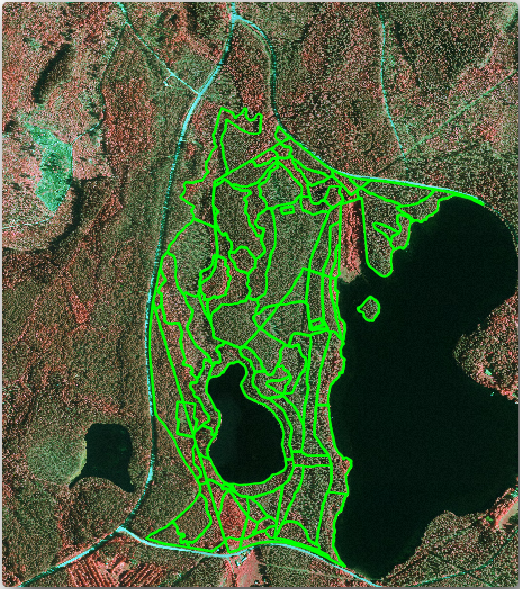
You can see that the northern section of the inventory area is still missing. Your task is to digitize the missing forest stands.
Before you start, spend some time reviewing the forest stands already digitized and the corresponding forest in the image. Try to get an idea about how the stands borders are decided, it helps if you have some forestry knowledge.
Some points to consider:
Which forests have deciduous species (in Finland these are mostly birch forests) and which ones have conifers (in this area these are pine or spruce)? In CIR images, deciduous species usually show up as a bright red color whereas conifers show as a dark green color.
How old is the forest? The size of the tree crowns can be identified in the imagery.
How dense are the different forest stands? A forest stand where a thinning operation has recently been done would show spaces between the tree crowns and should be easy to differentiate from other forest stands around it.
푸르스름한 지역은 황무지, 도로, 시가지, 아직 자라나지 않은 경작지 등을 의미합니다.
Don’t use zooms too close to the image when trying to identify forest stands. A scale between 1:3 000 and 1:5 000 should be enough for this imagery. See the image below (1:4000 scale):
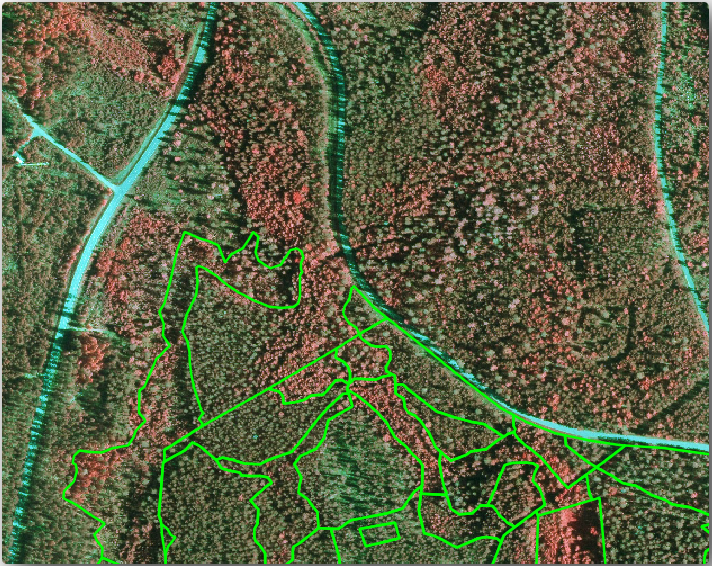
14.4.3. ★☆☆ Try Yourself: Digitizing Forest Stands from CIR Imagery
When digitizing the forest stands, you should try to get forest areas that are as homogeneous as possible in terms of tree species, forest age, stand density… Don’t be too detailed though, or you will end up making hundreds of small forest stands - and that would not be useful at all. You should try to get stands that are meaningful in the context of forestry, not too small (at least 0.5 ha) but not too big either (no more than 3 ha).
With these points in mind, you can now digitize the missing forest stands.
Set up the snapping and topology options:
Select the forest_stands_2012 layer on the Layers list
Start digitizing using the same techniques as in the previous lesson. The only difference is that you don’t have any point layer that you are snapping to. For this area you should get around 14 new forest stands. While digitizing, fill in the
StandIDfield with numbers starting at901.작업 완료 시 여러분의 레이어가 다음처럼 보여야 합니다.
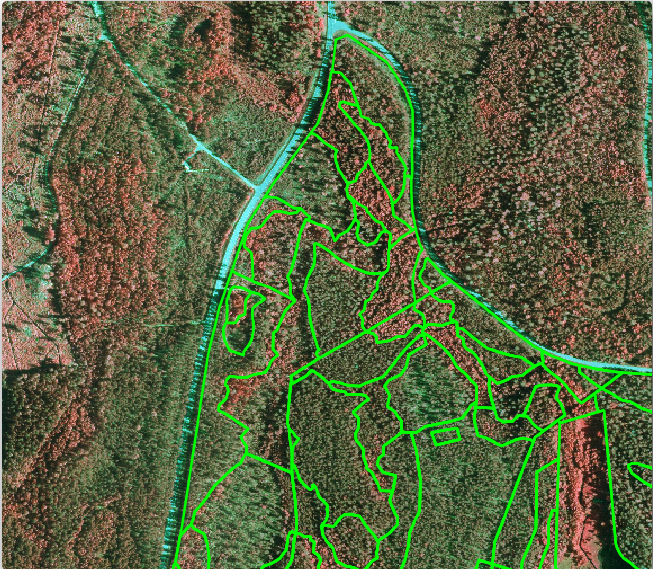
Now you have a new set of polygons showing the different forest stands in 2012 - as interpreted from the CIR images. However, you are missing the forest inventory data. For that you will need to visit the forest and get some sample data that you will use to estimate the forest attributes for each of the forest stands. You will see how to do that in the next lesson.
You can add some extra information about conservation regulations that need to be taken into account for this area.
14.4.4. ★☆☆ Follow Along: Updating Forest Stands with Conservation Information
For the area you are working in, there are some conservation regulations that must be taken into account when doing the forest planning:
보호종인 시베리아 하늘다람쥐(Pteromys volans)의 서식지가 2곳 발견되었습니다. 규제에 따르면, 서식지에서 반경 15m 구역을 절대 보존해야 합니다.
A riparian forest of special interest that is growing along a stream in the area must be protected. In a visit to the field, it was found that 20 meters to both sides of the stream must be protected.
You have a vector file containing the information about the squirrel locations and another containing the digitized stream running from the North area towards the lake.
From the
exercise_data\forestry\folder, add thesquirrel.shpandstream.shpfiles to the project.Use the
 Open Attribute Table tool to view the
Open Attribute Table tool to view the squirrellayer시베리아 하늘다람쥐로 정의된 위치가 2곳 있고, 보호해야 할 지역은 해당 위치에서 반경 15m까지라는 것을 알 수 있을 겁니다.
Let’s more accurately delimitate that area to protect. We will create a buffer around the point locations, using the protection distance.
메뉴에서 를 클릭하십시오.
Set Distance to
15 metersSet Buffered to
exercise_data\forestry\squirrel_15m.shpClick Run
Once the process is completed, click Close
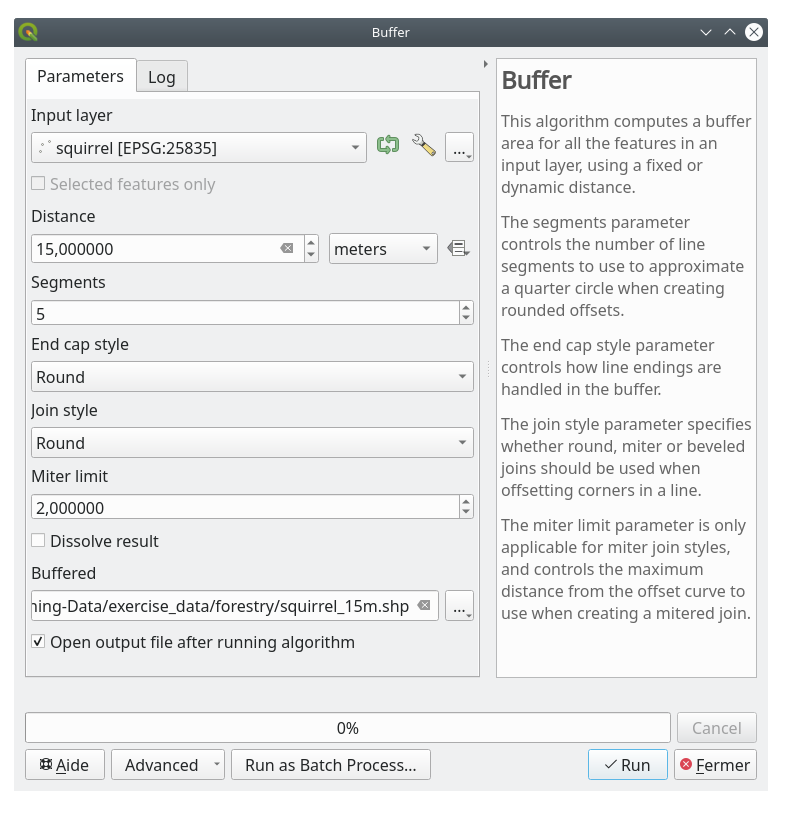
If you zoom in to the location in the northern part of the area, you will notice that the buffer area extends over two neighbouring stands. This means that whenever a forest operation takes place in that stand, the protected location should also be taken into account.

For the protection of the squirrels locations, you are going to add a new attribute (column) to your new forest stands that will contain information about locations that have to be protected. This information will then be available whenever a forest operation is planned, and the field team will be able to mark the area that has to be left untouched before the work starts.
To join the information about the squirrels to your forest stands, you can use the Join attributes by location algorithm:
메뉴에서 을 클릭하십시오.
Set Join type as Take attributes of the first matching feature only (one-to-one)
Leave unchecked Discard records which could not be joined
Set Joined layer to
exercise_data\forestry\stands_squirrel.shpClick Run
Once the process is completed, you can Close the dialog.

Now you have a new forest stands layer, stands_squirrel.shp
showing the protection information for the Siberian flying squirrel.
Open the attribute table of the
stands_squirrellayerSort the table by clicking on point_pr field in the table header.
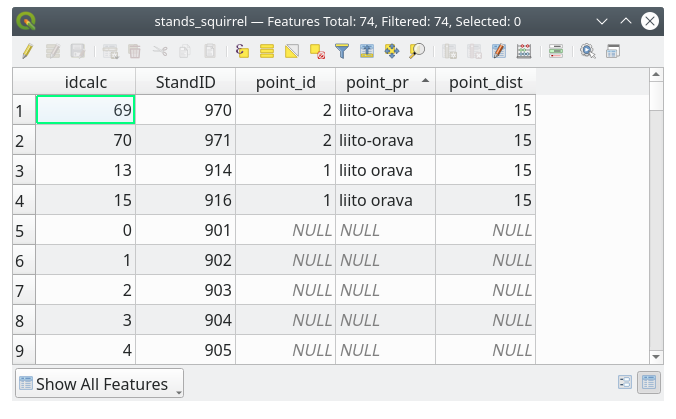
You can see that there are some forest stands that have the information about the protection locations. The information in the forest stands data will indicate to the forest manager that there are protection considerations to be taken into account. Then he or she can get the location from the squirrel dataset, and visit the area to mark the corresponding buffer around the location so that the operators in the field can avoid disturbing the squirrels environment.
14.4.5. ★☆☆ Try Yourself: Updating Forest Stands with Distance to the Stream
Following the same approach as for the protected squirrel locations you can now update your forest stands with protection information related to the stream. A few points:
Remember the buffer is
20meters around the streamYou want to have all the protection information in the same vector file, so use
stands_squirrel.shpas the base layerName your output as
forest_stands_2012_protect.shp
Once the process is completed, open the attribute table of the output layer and confirm that you have all the protection information for the riparian forest stands associated with the stream.
When you are happy with the results, save your QGIS project.
14.4.6. In Conclusion
CIR 이미지를 해석해서 수종경계를 디지타이즈하는 방법을 배웠습니다. 물론 보다 정확한 수종경계를 얻기 위해서는 연습이 필요하고, 토양도 등의 다른 정보를 활용하면 더 나은 산출물을 얻을 수 있습니다. 하지만 이제 이런 유형의 작업을 위한 기초를 습득했다고 할 수 있습니다. 게다가 다른 데이터셋으로부터 정보를 추가하는 것은 꽤 시시한 작업이었습니다.
14.4.7. What’s Next?
여러분이 디지타이즈한 수종경계는 향후 삼림 작업 계획을 위해 사용될 것입니다. 그러나 삼림에 대한 더 많은 정보가 필요합니다. 다음 강의에서는 여러분이 방금 디지털화한 삼림 지역을 목록화하는 데 필요한 표본구 집합과 함께, 삼림 파라미터의 종합 평가를 구하는 방법을 배울 것입니다.




